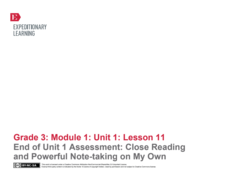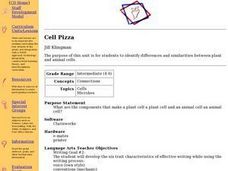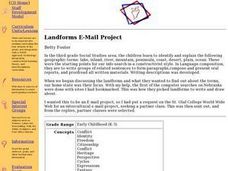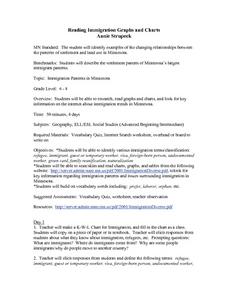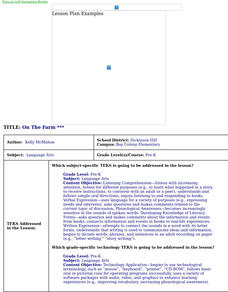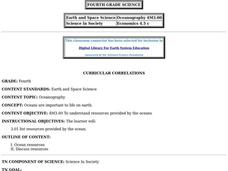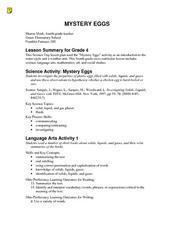Curated OER
Subjects and Predicates
Sixth graders explore writing techniques by reviewing sample sentences. In this writing subject lesson, 6th graders examine a list of sentences in which they identify both the subject and predicate. Students complete a subject and...
EngageNY
End of Unit 1 Assessment: Close Reading and Powerful Note-Taking on My Own
As the final lesson plan in a larger beginning-of-the-year unit to establish routines and teach close reading skills, this plan is designed as an assessment piece. Using the story, The Librarian of Basra, learners independently...
Curated OER
Describe Environmental Interrelationships
Students describe environmental interrelationships using list of criteria. They are able to explain organism interaction, based on definitions provided. Also, students can use references and worksheets, to describe effects of pollution...
Curated OER
Vivid Verbs
Students explore parts of speech by collaborating in groups. In this verbs lesson, students examine several boring sentences with their class and define verbs which can spice the sentence up. Students collaborate in pairs to enhance...
Curated OER
Under the Sea
Students identify and interpret that non-fiction books have features like a table of contents, a glossary, and an index, which can efficiently help them find information. They also identify how to narrow the search for information by...
Curated OER
Writing Example Paragraphs
Sixth graders explore language arts by writing basic paragraphs. In this writing techniques activity, 6th graders define an "example" paragraph and discuss techniques to prove a point in one paragraph. Students practice writing their own...
Curated OER
The Raven: Creator of the Universe?
Students explore biology by researching birds in class. In this raven identification instructional activity, students utilize the Internet to identify the anatomy, habits and habitat of ravens. Students write descriptive paragraphs about...
Curated OER
Cell Pizza
Students identify parts and functions of microscope. Students watch video, Cells and Life about cell parts with actual pictures and actual cells. Students discuss video and identify parts of the cells that animals and plants have in...
Curated OER
Landforms E-mail Project
Young scholars identify and explain geographic terms. They write descriptions of the terms. Students discuss landforms and draw pictures to illustrate them. Young scholars compose and present oral reports about landforms.
Curated OER
Reading Immigration Graphs and Charts
Students examine the settlement patterns and land use in Minnesota. In groups, they practice reading immigration graphs and charts and discuss why immigrants settled where they did. They are also introduced to new vocabulary related to...
Curated OER
Nevada, A to Z
Fourth graders explore U.S. Geography by reading a timeline. For this Nevada history lesson, 4th graders identify the geographic location of Nevada and discuss the history. Students read the book S is for Silver: A Nevada Alphabet and...
Curated OER
Description of Materials for Parts of a Fossil Lesson Plan
Students study fossils. In this fossils lesson, students discuss and study real fossils. Students color in pictures of fossils and their sections. Students then identify fossil picture parts and names. Students write definitions for...
Curated OER
Signs of Spring
Learners identify the first signs of Spring. They track birds and butterflies on their journey North.
Curated OER
On The Farm
Students identify animals found on farms. They create a farm picture using KidPix Software. They can combine their pictures to create a class book on farm animals. They can use graphic pictures from clipart to decorate the cover of the...
Curated OER
Pond Habitats
Young scholars define what a pond habitat is and explain what animals live in this habitat. They discuss what can harm or destroy a pond habitat. They create a poster of what could harm a pond habitat including illustrations and...
Curated OER
Oceanography
Fourth graders explore the importance of oceans in supporting life on earth and identify resources obtained from the ocean.
Curated OER
Populations and Ecosystems
Sixth graders examine the factors that influence the stability of ecosystems. They construct a miniature ecosystem in a jar that includes plants, small fish, and snails, record the population changes over a period of four weeks, and...
Curated OER
Five Senses-Introduction
Students explore the parts of the body that are used to develop the five senses. They conduct a nature walk. Students identify the things they see, hear, smell, and touch. They create a graphic organizer to organize their answers.
Curated OER
How Does My Government Grow?
Students identify the core democratic values. They explain how the values affect their life in America. They also relate the topic of philantrophy to the core values.
Curated OER
Living Organisms
Third graders examine pond water samples using hand lenses while working in small groups. They find specimens of living organisms in the water samples. Finally, the draw a picture of the organisms and label them using descriptive...
EngageNY
Solution Sets to Simultaneous Equations (part 1)
How are systems related? Build on your pupils' previous knowledge of solving systems of equations by introducing systems of inequalities. Learners explore similarities between systems of equations and inequalities to make a strong...
EngageNY
Solution Sets to Inequalities with Two Variables
What better way to learn graphing inequalities than through discovering your own method! Class members use a discovery approach to finding solutions to inequalities by following steps that lead them through the process and...
Curated OER
Mystery Eggs
Students investigate the properties of plastic eggs filled with solids, liquids, and gases and use these observations to hypothesize whether a chicken egg is hard-boiled or raw.
Curated OER
Mapping Roxaboxen
Fourth graders read Roxaboxen and draw a map of the Roxaboxen community. In this language arts and geography lesson, 4th graders use specifications given, adding features to the map as described in the book and creating a legend.

